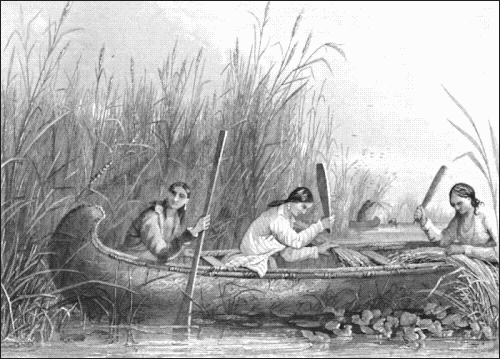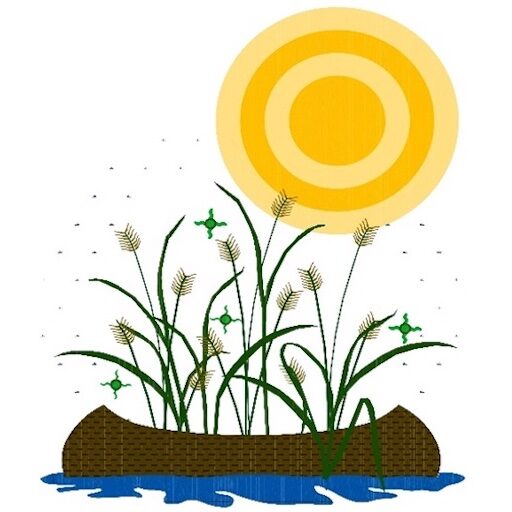The History of Manoomin
Did you know?…
- The earliest settler account of wild rice harvesting in North America dates from the 17th century. Pierre-Esprit Radisson describes the importance of wild rice as a staple food to those he encountered in the Great Lakes Region between 1653 and 1684 (Chambliss 1940, p. 203 – in Report by Jeff Beaver, 2.2). As well, Reverend Pere Menard, a 17th century Jesuit Missionary gave a detailed description of native harvesting, processing and storage of wild rice in the Jesuit Relations (Avery and Pawlick, 1979 – in Report by Jeff Beaver 2.2). Other European missionaries, explorers and traders who travelled in the Great Lakes Region in the 17th and 18th centuries “marvelled at the profusion of wild rice stands and stressed that they could not have completed their long journey without this food .” AIken et al. 1988 – quoted in Report by Jeff Beaver);
19th Century

- In Southeastern Ontario, the settlers of the early 19th century noted the cultivation of wild rice on Lake Scugog by Mississauga Indians (Frost 1973: 50). In treaties with the Crown of 1818 and 1856, the Mississauga Nation surrendered lands in South-eastern Ontario. In these treaties, aboriginal rights to harvest wild rice stands throughout their homeland were not surrendered. However, the construction of the Trent canal system which took place in several stages between 1837 and 1920, raised water levels on lakes and marshes and eventually destroyed wild rice stands throughout the region (Howard et al. 1987) .” (Report by Jeff Beaver)
- “Between the years 1891 and 1915, representatives of the Mississauga Nation lodged a series of complaints with the Federal government. The Mississaugas claimed that the increase of water levels on Rice Lake was damaging the wild rice stands and requested that natural water levels be restored. In written correspondence, the Federal government acknowledged the Mississauga Nation’s exclusive right to the wild rice stands. However, Federal officials claimed that the rising of water levels could not damage wild rice (Howard et al. 1988 : 38-45). Between the years 1857 and 1923 the Mississauga Nation also placed restrictions on who could harvest wild rice stands at Rice Lake.” (Report by Jeff Beaver 2.2)
- There is some historical evidence that the Mississauga Nation managed the wild rice at Rice Lake until the 1920s when the wild rice stands were destroyed through the raising of the water levels. (Report by Jeff Beaver)
- In 1994, 4 members of the Alderville First Nation conducted a wild rice inventory – locating and mapping all existing wild rice beds.
- The project was not funded again until 2007- 2008 – 2009 assisted by Plenty Canada, a non-profit organization – to do mapping, seeding, processing involving Indigenous youth.
Field Research and Revitalization
- The Field Research in 2010 met with a difficult season – high winds and driving rain. But – with crew from the Heritage Film project and 3 Parks Canada staff, 4 harvesters gathered 40 lbs of green rice from Bald Lake, at Emily Creek 40 lbs of rice, Little Bald Lake, 20 lbs, Mitchell Lake 10 lbs.
- Also in 2010 during trial seeding in Chemung Lake and Buckhorn Lake – 10 lbs were seeded; 20lbs of Northern Rice , 1lb Southern Rice in Stoney Creek, Alderville. A project drafted to explore the relationship between muskellunge and wild rice there.
- Threats to the survival of wild rice throughout the Trent-Severn Waterway are increasing as more natural shoreline is changed to suit the cottage and tourism industry….landowners find ways to try to get rid of it – refer to it as “weeds”, got permits to chemically kill it, dredging it, hand pulling plants. Every year the same – also new docks, new cottage development, shoreline destruction, boat paths cut through, piles of rice plants on docks. Raising water levels drowns the rice. Lowering water levels in late fall requires more research – perhaps exposing rice seeds to more shorebirds, ducks and geese? Carp introduction has meant an increase ino carp populations into the millions. Controversy over airboat harvesters. Concerns abound over hybridization of wild rice (especially in the U.S.)
- See all 15 recommendations at the end of the Report
Threats and Challenges

